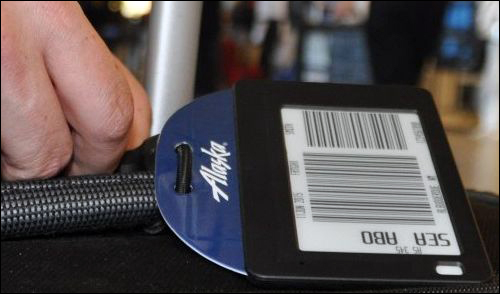Alaska Airlines is providing 500 of its frequent fliers with high-tech luggage tags that have the potential to speed-up the check-in process. The airline is employing Vanguard ID Systems‘ ViewTag, which comes with an electronic paper (e-paper) display, a Bluetooth Low Energy (BLE) radio and a passive EPC Gen 2 ultrahigh-frequency (UHF) RFID inlay. In November 2016, the airline plans to evaluate the results before deciding whether to continue using the ViewTag or make it available to more passengers.
The ViewTag has been in the works for more than a decade, in several forms, to replace the bar-coded, one-time-use paper luggage labels that airlines currently utilize to identify and track their passengers’ checked baggage. The ViewTag is designed to serve as an intelligent, electronic, reusable luggage tag aimed at sparing passengers from having to stand in line, while enabling airlines to better locate bags. In its earliest version, the ViewTag included Near Field Communication (NFC) and UHF RFID technology, as well as a small e-paper screen for displaying the three-letter code representing the passenger’s destination airport (see Reusable Electronic Baggage Tag Powered by RFID). The latest version, being used by Alaska Airlines, features a larger e-paper display screen, as well as a Bluetooth radio so that a user can communicate with the tag via the app running on his or her smartphone, and use the phone’s built-in Bluetooth technology to update travel information, such as a flight number and destination, in text and bar-coded forms.

The latest version of the ViewTag comes with an NFC-enabled radio, which could also be used to update the travel information displayed on the e-paper display. At this time, however, iOS devices are not designed for this NFC function.
During the past few years, Vanguard ID has been working with Alaska Airlines’ customer research and development team, known as CX Labs, which aims to reduce some of the common hassles of air travel. The team was created in 2013, and one of its projects has been reducing airport wait times. The group has tested a fingerprint boarding pass and ID using biometrics, and is now also focused on finding a better method of tracking bags’ movements.
The airline initially tried out the ViewTag last summer, providing the tag to 50 employees and the same number of customers. “So far, our employees and customers who have tested the tags have been delighted,” says Loesje DeGroen, Alaska Airlines’ manager of customer research and development. “Overall, we deemed both the employee test and the 50-person customer test a success. And as a result, we will expand the test group to 500 customers this summer.”
The airline already offers an app for passenger check-in (available at Google Play and iTunes), and the 500 frequent fliers using the ViewTag can utilize the app to check in a bag. The tag, measuring 2 inches by 3 inches, is attached to the bag via a nylon cord designed to be durable, according to Richard Warther, Vanguard ID’s president and CEO. Because the ViewTag has a Bluetooth radio, it can communicate with smartphones and tablets once the tag’s power is activated. (The tag’s battery will typically last for three to five years.)
First, a passenger signs into the phone app and follows prompts to check in for a flight. This can be done anywhere 24 hours before the flight—at home, in a hotel, in the back of a taxi, or at the airport itself. The phone needs to be held near the tag to communicate with its Bluetooth radio. Once a passenger indicates that he or she has a bag to check in—which is linked to the travel information that person has entered—the app instructs the tag to display the flight number and the destination airport’s three-letter symbol in both text and bar-code forms. That information remains on the tag display until it is changed or removed via the app. The user then simply shows his or her ID at the Alaska Airlines counter and drops off the bag. There is no need to print a conventional paper luggage tag and attach it to the bag.
The ViewTag contains an Impinj Monza 5 RFID chip with an Avery Dennison inlay, though he says the company could use other RFID hardware in the future.
Airline or airport personnel could use the tag’s UHF RFID capabilities to quickly identify the bag at the airport, and send updated information to customers regarding the location of their luggage. For instance, Warther says, if an RFID reader were installed at the conveyor belt that receives bags from an arriving flight, it could capture each bag’s tag ID. That information could then enable the airline to verify that all bags were received (and when this occurred), route them to the proper carousel and forward that data to the bags’ owners via the app. Those passengers could, for instance, receive an alert through the app that their bags were available for retrieval at a particular carousel.
Conversely, if a bag were misrouted and failed to arrive at the airport as expected, the passenger could receive an alert and be instructed to input the address where he or she would like the luggage to be delivered once it arrived. This would spare the customer from having to wait at the baggage-receiving area to report a missing bag.
Alaska Airlines, however, is not offering this functionality at the present time. Instead, it is focusing only on the ViewTag’s ability to expedite the check-in process. In November, DeGroen says, the airline intends to review the results based on customers’ comments about their experience. She says she cannot comment on how the company might opt to use the ViewTag or RFID technology in the future.

